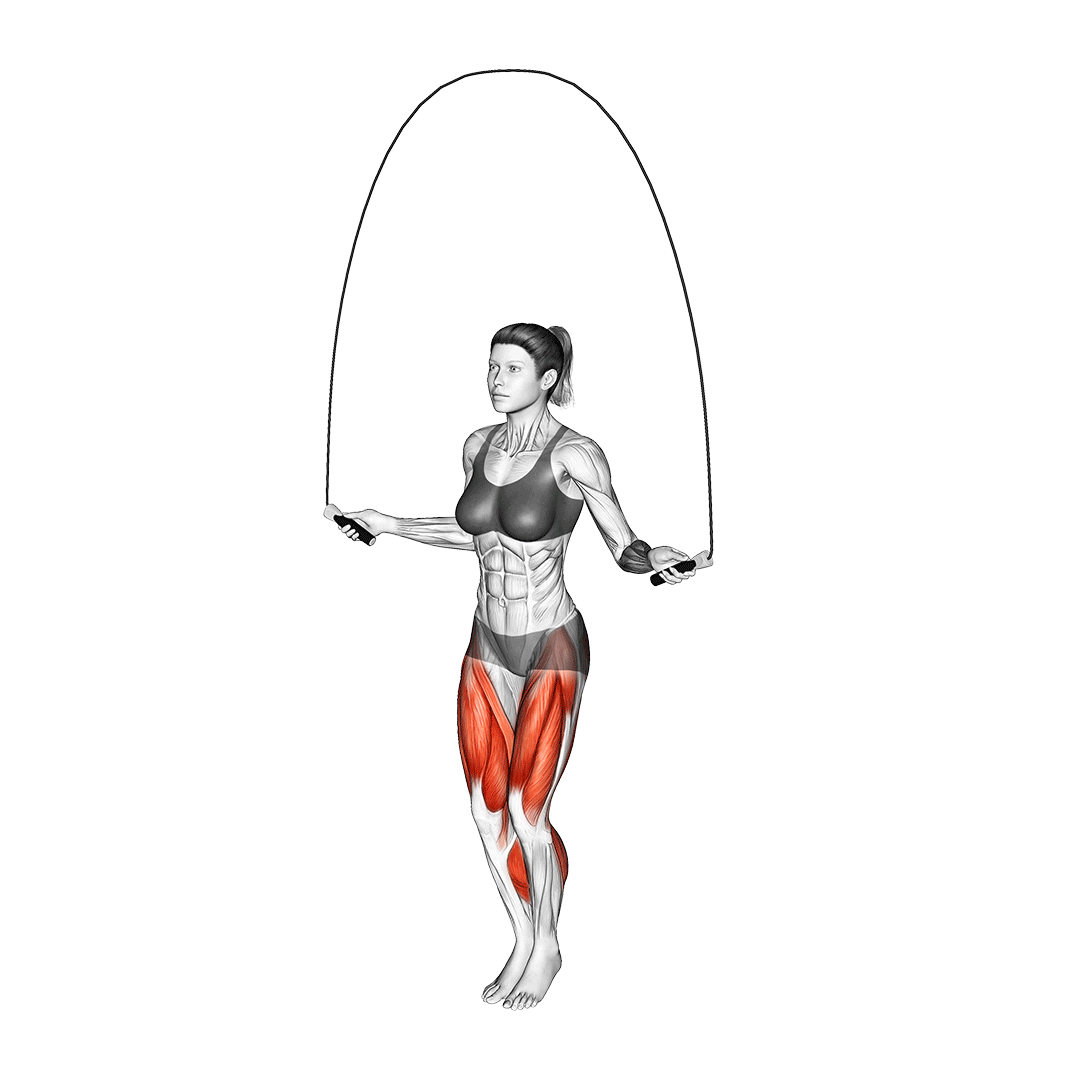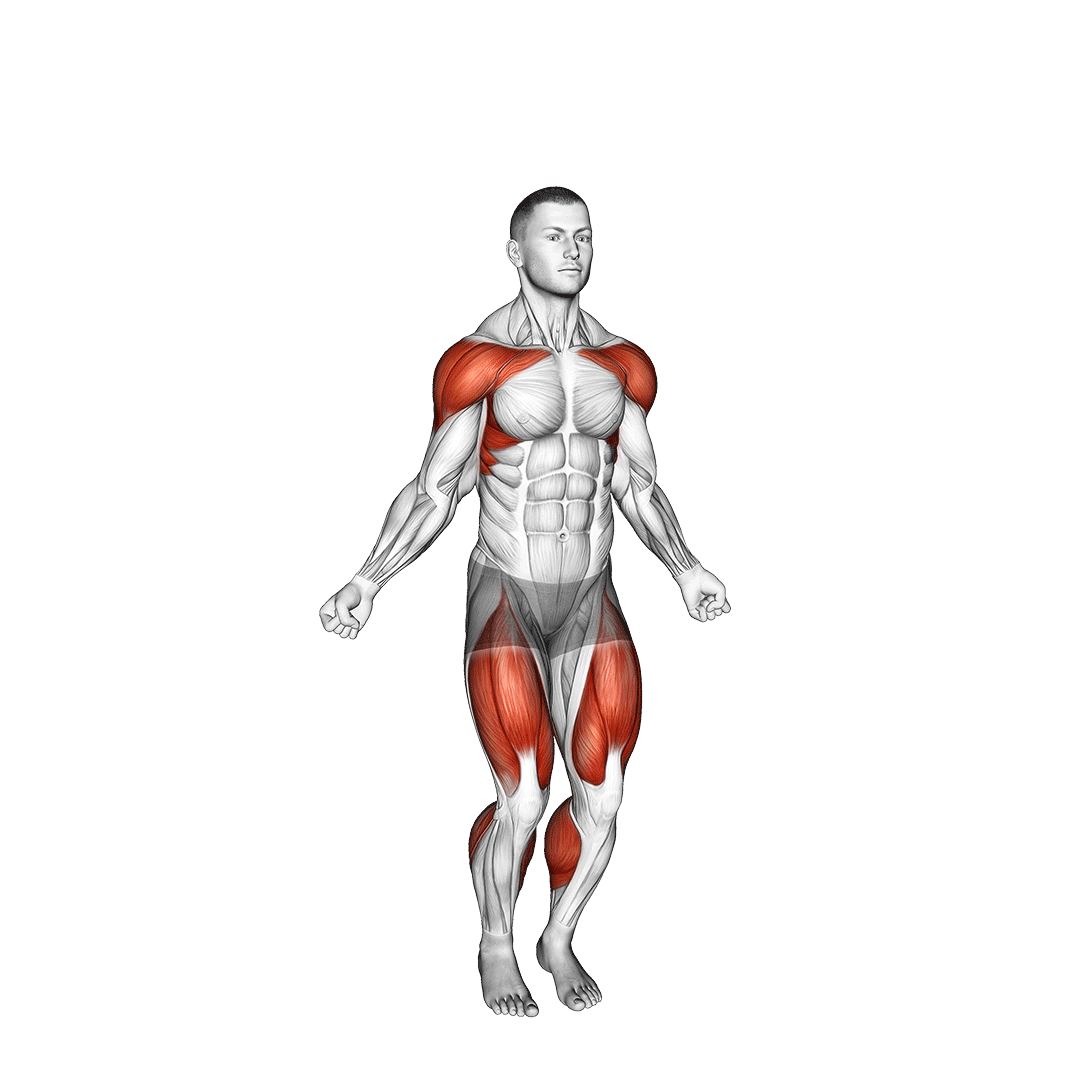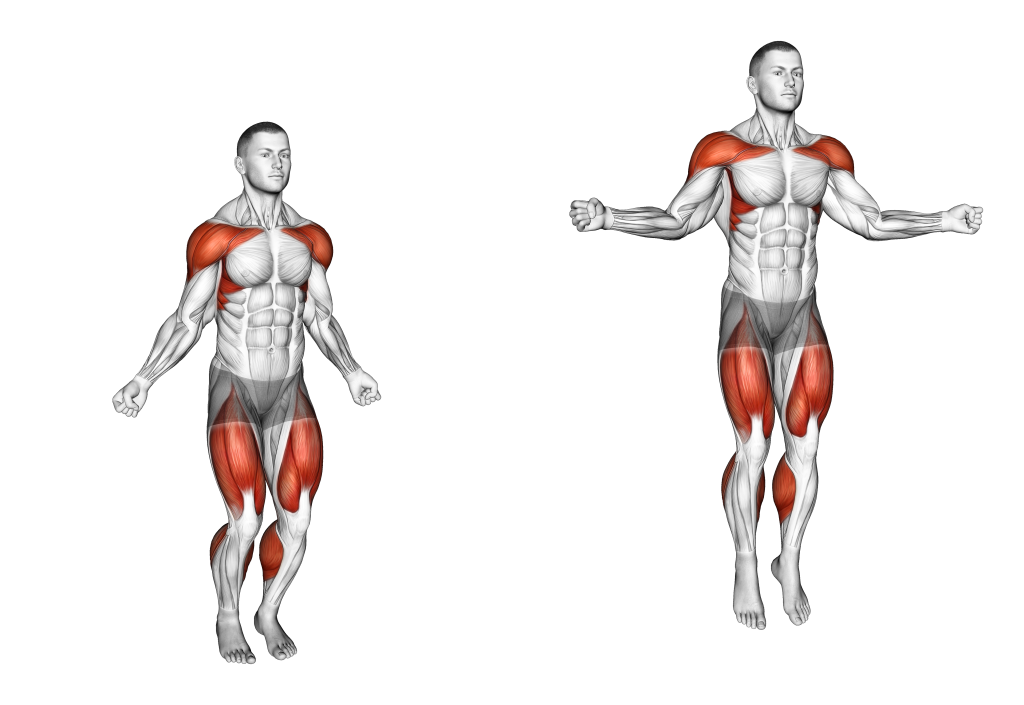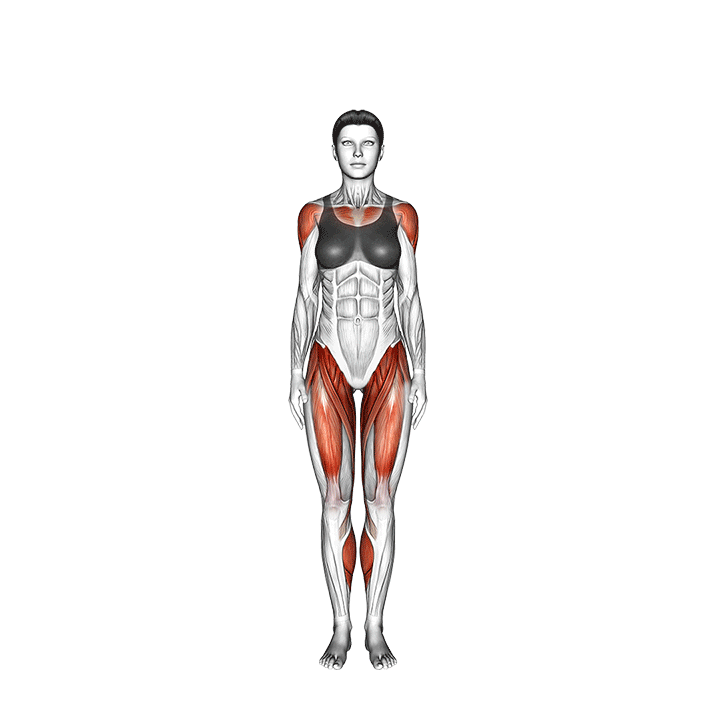Jump Rope Without Rope: Does it Do Anything?
Skipping or using a jump rope is a pretty well-established way of getting your workout in - but what if there’s no jump rope to be used?
In truth, whether or not you are jumping with a rope is largely inconsequential. Doing so will retain much the same benefits as jumping with a rope, and differs only slightly in terms of effectiveness.
So - can you jump rope without a rope? Yes, undoubtedly.
However, minute differences in how the exercise is performed with a jump rope will mean that doing so without one can comparatively reduce its effectiveness as an athletic training tool, and as a method of caloric expenditure.
What is Jump Roping?
Jump roping or skipping is the act of hopping in place as the arms whip a two-handled rope in a circular manner, with the exerciser jumping over the rope as it swings towards their feet so as to complete a full circle around the body.

In technical terms, jump roping as an exercise is classified as a multi-joint compound aerobic movement with use cases like caloric expenditure, tempo training, sports-specific practice and cardiovascular fitness development.
It is most often performed for a given set of time, rather than sets and repetitions, and may be encountered in anything from competitive football training plans to at-home weight loss programs.
Can You Jump Rope Without a Rope?
While there’s no substitute for actually jumping with a rope, it is entirely possible for at-home exercisers to perform the exercise without actually holding a jump rope in their hands.
This is occasionally referred to as “faux” jump rope or “invisible” jump rope.

Doing so retains much of the same benefits as skipping with a rope, and is perfect for exercisers who don’t require a highly specific form of training stimulus in their workout.
That being said, it is still better to perform the exercise with the use of a jump rope, as there are certain inherent disadvantages to jumping without one.
The Disadvantages of Jumping Without a Rope
The primary issue with jumping without a rope is that the exerciser will have trouble maintaining a consistent tempo and movement pattern, leading to a less effective workout.
Obviously, in order to create the same benefits as skipping with a jump rope, the exerciser will need to move in the same manner - regardless of whether they are actually holding a rope or not.
Making use of tempo and timekeeping methods like a stopwatch, motion tracker or heart rate monitor can help ensure that the ropeless skipping is as similar in benefits as possible.
In addition, certain types of athletes like boxers or rowers may make use of jump ropes because of its capacity to improve full-body coordination and proprioception - another aspect that is not present when skipping without a jump rope.
Furthermore, certain types of jump rope can act as minor sources of resistance during an exercise - thereby providing muscular recruitment that would not be otherwise possible without said jump rope.
How to Jump Rope Without a Rope
Standing upright in a clear and safe space, the exerciser will hold their hands out to their sides as if actually holding a jump rope.
Then, in time with their desired rhythm, the exerciser will rotate their wrists and hop upwards - generating force with their glutes and calves.

As they land, they will bend at the knees and keep the lower body loose so as to better diffuse the impact across their body.
This action may be repeated as many times as needed within the time frame of the set.
Is Rope-less Jump Rope Just as Effective?
While we’ve established that jumping without a rope is possible, that isn’t to say that it is as effective as actually using a jump rope.
As one can tell from the aforementioned disadvantages, ropeless skipping isn’t quite as useful for more advanced training purposes, and is largely counterintuitive to training goals like building up a sense of rhythm or consistent fat burn.
Unless specifically in a situation where there is no access to a jump rope, it is best to perform the exercise with one - even if only to ensure that the beneficial effects are maximized.
Jumping Rope Without a Rope - the Benefits
Though the disadvantages of skipping without a rope have already been covered, there are actually several advantages to doing so that many exercisers overlook.
Burns Calories and Helps With Weight Loss
Regardless of whether it is performed with or without a rope, skipping is an aerobic exercise that raises the heart rate and burns a significant amount of calories per minute.
Some estimates place the average between 8 and 12 calories per minute of jumping - quite a bit more than what one would burn lifting weights or cycling at a moderate pace.
Builds Up the Calves, Quadriceps and Glutes
Jumping is an intensive exercise for the muscles of the lower body, as it involves rapidly moving the entirety of the exerciser’s weight against the direction of gravity.
As such, it should be no surprise that jump roping (even without a rope) can build up the muscles of the calves, glutes and quadriceps - or nearly every major muscle group in the legs.
Great for Beginners
Jump roping without a rope is particularly useful for beginners, as they may not yet have the coordination or sense of rhythm to successfully make use of a jump rope.
Practicing without actually using a rope can allow them to master the fundamentals in a safer and more consistent manner, and help build the fundamental muscle memory needed.
Convenient and Accessible
It goes without saying that an exercise with no equipment requirement is more convenient than an equipment-based one. Skipping without a jump rope can be done practically anywhere with enough space, and can be done in the comfort of an exerciser’s home, if so needed.
Less Likely to Result in Accidents
While the majority of jump rope injuries are caused by repetitive strain (i.e. shin splints from the impact of landing), exercisers may occasionally injure themselves by tripping over the jump rope. This is clearly not as much of a risk when no jump rope is used.
How to Get the Most Out of Jumping Without a Rope
While jump roping without a rope is less effective than with one, there are several steps an exerciser can take to help mitigate this difference.
Time the Tempo
One of the main reasons why jumping without a rope is less effective has to do with consistent timing. With a jump rope, the exerciser will be forced to stick to a specific rhythm of movement so as to keep the rope taut and moving.
In order to help create the same effect without a jump rope, exercisers can rely on a clock or manual counting to maintain a consistent tempo.
To do so, all they have to do is jump a certain number of times within a given time frame, thereby ensuring that the tempo maintains consistent throughout the workout.
Look Into Alternatives
Skipping without a rope is less than ideal, and it is entirely fine to opt for alternative exercises instead of jumping without a jump rope.
Exercises like plyometric jumps and box jumps can help recreate the same intensity and muscular recruitment as jump roping, while sprinting can match it in terms of fat burning potential.
Reduce Landing Impact
Discomfort and swelling can be major limiting factors in high volume jump rope workouts. This sort of response is driven by the high impact nature of jumping as a whole, and it is best for exercisers to perform their jump rope sets (even without a jump rope) in a manner that minimizes the damage given to their joints.
To do so, every landing should include the exerciser bending their knees and hips, as well as extending the forefoot while they fall so as to better distribute force throughout the body.
For even better protection, exercisers may perform jump roping atop a foam mat or similarly soft surface.
Try Out Skipping Variations
Taking things even further, exercisers performing ropeless jump rope can also replicate the numerous variations of jump roping.
Alternating the feet between jumps, swinging the “rope” between the feet, crossovers and double-unders are all skipping variations that increase the intensity and difficulty of the exercise.
Alternatives to Jump Rope if You Don’t Have a Rope
If you’ve decided to forego the jump-rope-without-rope option, there are several alternative exercises and equipment that may be employed instead.
1. Cordless Jump Ropes
If your reason for looking up “jump rope without a rope” is because you dislike actually using a jump rope, it is entirely possible to instead purchase a jump rope without an interconnecting cord.
These implements primarily consist of two handles with a weight at the end so as to simulate the resistance of a cord - and are miles more effective than simply jumping with no equipment whatsoever.
2. Squat Jumps, High Knees, and Jumping Jacks
More effective than jumping without a rope; exercises like the squat jump can match the muscular recruitment and movement pattern of jump roping - all in a manner that is significantly more intense.

Switching out ropeless jump rope with jump rope alternative exercises is the ideal choice for calisthenic athletes and individuals wishing to build muscle mass in their lower body.
3. Alternative Aerobic Exercises
For exercisers wishing to perform jump rope for the purposes of weight loss and cardiovascular fitness, it may be more preferable to instead go swimming or running - not only will doing so burn more calories in a shorter frame of time, but it will also be more effective in terms of cardiovascular development.
Frequently Asked Questions (FAQ)
What Can You Use Instead of a Jump Rope?
For the most part, it is a bad idea to use makeshift fitness equipment - especially in the case of jump rope. Doing so could potentially result in injury, and instead it is a better idea to pick an alternative exercise if you do not have access to a jump rope.
Does Skipping Without Rope Increase Height?
The answer is that it depends - individuals who have not yet stopped growing will likely receive a small boost in height growth by performing aerobic exercises like skipping. However, if your epiphyseal plates have sealed, it is unlikely that anything can make you grow taller.
What is the Point of a Ropeless Jump Rope?
Ropeless or cordless jump rope exist as an alternative to conventional jump ropes - often for individuals who dislike corded jump rope, or for those who have exceeded it in terms of training applicability.
Many modern cordless jump rope will feature weights at the ends of the handles to help simulate the resistance and movement of a regular rope, and can even track things like repetitions performed, heart rate and jump speed.
A Few Reminders
So - you can jump rope without a rope, but it’s not quite the best option.
Regardless of whether you wish to perform “faux” jump rope or have opted for an alternative, it is important to ensure that you perform your exercises with perfect form and a focus on safety.
If you are unsure of how to perform a particular exercise, it is best to seek out professional advice.
References
1. Chottidao M, Kuo CH, Tsai SC, Hwang IS, Lin JJ, Tsai YS. A Comparison of Plyometric and Jump Rope Training Programs for Improving Punching Performance in Junior Amateur Boxers. Front Bioeng Biotechnol. 2022 May 24;10:878527. doi: 10.3389/fbioe.2022.878527. PMID: 35685089; PMCID: PMC9171322.
2. Trecroci A, Cavaggioni L, Caccia R, Alberti G. Jump Rope Training: Balance and Motor Coordination in Preadolescent Soccer Players. J Sports Sci Med. 2015 Nov 24;14(4):792-8. PMID: 26664276; PMCID: PMC4657422.
